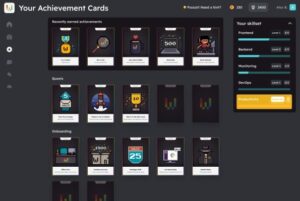Imagine building some of the most sophisticated hardware-driven technologies in the world — spacecraft, drones or autonomous vehicles. Then imagine being unable to easily share your data to different teams, having to use clunky user interfaces and relying on a single person manually inputting data in an Excel spreadsheet to bottom-line your project.
“You’d be shocked at how archaic the tools are,” Lucy Hoag, co-founder of Violet Labs, said. She wasn’t referring to the sophistication of the tools, but the way in which the hardware production toolset is balkanized across both teams and tasks. It’s a problem, common across the industry, that she and her co-founder Caitlin Curtis say leads to major inefficiencies.
To solve this problem, Violet Labs is developing a cloud-based platform that can act as a single source of truth, collecting the data from all the tools and making them easily accessible across teams. Hoag likened the product to Zapier, which uses APIs to talk to different tools. The Violet platform would function similarly, generating API requests and collating the data into a single powerful database. The company is also developing a no-code user interface that can act as an all-in-one toolkit for hardware engineers.
Hoag, who has a background in astronautical engineering, cut her teeth building a tool called Spider to automate the satellite design process. That led her into a career working for some of the biggest companies in the world: Google, Waymo, Lyft and most recently Amazon, for its broadband satellite initiative Project Kuiper. When she returned to aerospace at Amazon, after years mostly working on self-driving cars, she said she was shocked at how little the tool set had developed.
“We’re really still doing things the exact same way,” she said. “At Kuiper is where I met Caitlin and we both really bonded over that frustration. That brings us here.”
“Here” is quitting their jobs to work on the Violet platform full-time. The duo is now eight months deep into building the company to develop that tool. Violet Labs just closed a $4 million seed round to accelerate product development as Hoag and Caitlin race to market later this year. The round was led by Space Capital, with participation from MaC Venture Capital, Felicis, V1.VC and technologists.
A multitude of software tools are used through the lifecycle of hardware product development, from more generalized tools to the very specialized. The tools themselves are very sophisticated but, as Hoag put it, “the problem is they really don’t talk to each other.” To work around this problem, teams will usually hire a system engineer or a technical program manager to manually maintain a source of truth between the different tools.
Let’s make it concrete. Say a mechanical engineer is working on building a spacecraft. She has the physical model of the satellite in a CAD design software, like Solidworks, and she needs to get parameters related to the spacecraft’s Guidance, Naviagtion and Control (GNC) system to another team. Today, she might manually extract those parameters, insert them in a Google Sheets document, email that to the system engineer or post it to a workspace like Confluence, and then the GNC team would manually take those values and hard-code them into GitHub or Bitbucket.
“It’s just incredibly slow,” Hoag explained. “As you can imagine, it’s error-prone because there are so many humans in the loop and so many steps in the process. It’s needlessly inefficient, and that’s what Violet is trying to solve.” She added that teams could go from spending months or many months to get something built in prototype to as little or days or weeks with Violet’s platform.
In the worst cases, the legacy way of doing things isn’t just inefficient — a problem on its own, for companies that want to aggressively get products out to market — but it can be disastrous. One notorious example is the Mars Climate Orbiter, a space probe launched in December 1998. The mission resulted in failure due to a navigation error — specifically, a failure of translating units from metric to Imperial. It resulted in a complete loss of payload. The Violet platform, Hoag says, would help teams avoid errors like that one.
The company is still just Hoag and Curtis, who’ve been working on a prototype and chatting with customers in the aerospace, autonomous vehicles and robotics fields. Heartened by the feedback they received, the duo decided to raise funds back in May to bring the product to market faster. Their pitch obviously resonated. Ryan Isono, VP at Felicis, said he heard echoes of these pain points from others in the hardware and robotics space.
Violet Labs has already landed a few agreements with some of the applications they plan to integrate with, including the product lifecycle management tool Duro and the requirements management software Jama. The company plans to use the funding to accelerate product development and hire more full-stack software developers.
Hoag said that while there’s been massive innovation for software development, hardware engineers are noticing the lack of innovation on their side of things.
“We’re at this inflection point where there’s all these different companies and startups and people being empowered to build these systems,” she said. “We feel that this next generation of engineers won’t tolerate this outdated toolset. They will demand something that’s more streamlined or data-driven or frictionless, and we want to be the ones to enable that.”










